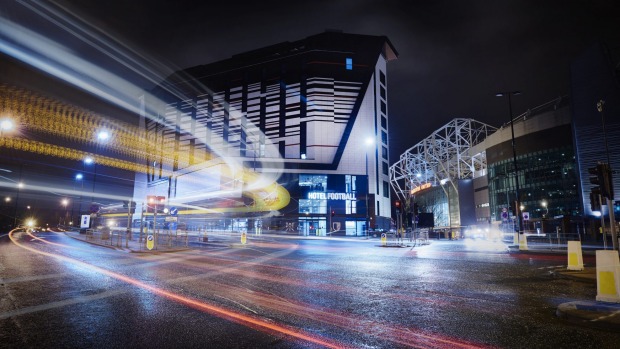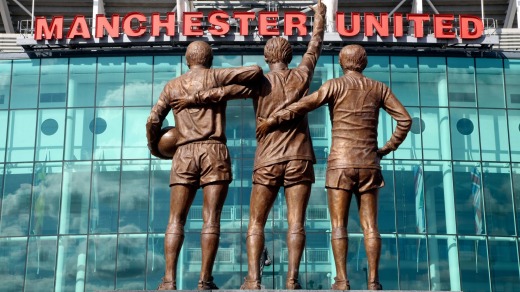
"Football was seen as a cure for the Scuttlers," says John Consterdine, as he navigates his black cab through Manchester's web of brick-warehouse-lined backstreets. Scuttlers, he explains, were the young gangs who fought violent turf wars across "Cottonopolis", as this city was known in Victorian times thanks to its booming cotton industry. "The mill owners were fed up of their workers fighting and coming in on Monday mornings with broken noses and cauliflower ears. The growing popularity of football helped reduce the scuttling. It was a simple game: all you needed was a ball."
Greater Manchester born and bred, Consterdine operates a range of themed taxi tours, covering everything from the city's industrial heritage to its "Madchester" music scene. Quite often, topics blend together. As Consterdine says: "Everything crosses over in Manchester – footy, music, fashion, industry; it's all interlinked." It is, however, the sport's impact on Manchester – and its evolution from working-class hobby to multibillion-dollar global business – that fuels today's bespoke tour.
"On one side of Manchester," Consterdine says, "we've got the world's richest football club [Manchester City; owned by Abu Dhabi's royal family]; on the other side, the world's best-supported club [Manchester United]. In centre, we have the National Football Museum [nationalfootballmuseum.com], plus all the bars and restaurants that players, past and present, have either owned or been known to frequent. So there's plenty to take in."

Consterdine had picked me on the Spring Gardens thoroughfare, opposite Rosso, an upmarket Italian restaurant owned by ex-United captain Rio Ferdinand. It's down the road from Pretty Garden, Liam Gallagher's menswear boutique. The Oasis frontman – and celebrity City fan – is one of the notable figures on the mosaics decorating Afflecks Palace, a vintage clothing and curios emporium on Tib Street.
Gallagher appears alongside Morrissey and The Stone Roses, characters from Coronation Street (think: Jack Duckworth and Hilda Ogden) and United footballing legends George Best and Eric Cantona. Best, who famously dazzled on and off the pitch, ran two Manchester nightclubs in the 1960s and '70s.
I perch myself where Cristiano Ronaldo liked to sit during his United days.
One, Oscar's (now The Tiger Lounge), is just off Moseley Street, where in 1888, in what was the Royal Hotel and is now a bank, the Football League was founded. The precursor to today's money-spinning English Premier League, it comprised 12 teams from the industrial heartlands of the Midlands and Northern England (including Aston Villa, Burnley and Blackburn Rovers). They were soon joined by Manchester City – born St Marks, a church team, in 1880 – and Manchester United, which started life as Newton Heath railway team in 1878.
Venturing past formerly Scuttler-riddled Ancoats, where smart new residential developments are flourishing on post-industrial brownfield sites, we come to Bank Street in the suburb of Clayton. "That's where United's old ground was," Consterdine says, pointing at land now occupied by the National Cycling Centre.
It's part of the sprawling Sportcity complex, which includes City's Etihad Stadium and copious other impressive venues that emerged for the 2002 Commonwealth Games. Sick of the industrial pollution that once blighted eastern Manchester, United fled for the then leafier climes of western Manchester, where, in 1909, Old Trafford was purpose-built by architect Archibald Leitch. Like iconic future managers Matt Busby and Alex Ferguson, Leitch hailed from Scotland.
Driving via Salford Lads Club – which featured on The Smiths' The Queen is Dead album cover – John drops me off at Old Trafford, where I join supporters from at least a dozen different countries on a tour of the "Theatre of Dreams". A wry guide regales titbits about United legends as we visit the stands, press conference room, walk down the players' tunnel and beside the pitch, and explore the home dressing rooms (I perch myself where Cristiano Ronaldo apparently liked to sit during his United days). Post-tour, you could spend hours in the brilliant museum, where a treasure trove of memorabilia and multimedia clips charts the club's highs and lows.
Run by five former Red Devils – Ryan Giggs, Gary and Phil Neville, Paul Scholes and Nicky Butt – Hotel Football opened across from Old Trafford in March. Containing 133 stylish, soccer-flavoured rooms, a rooftop mini-football pitch and slick Cafe Football (which serves dishes such as Scholesy's steak pudding, chips, peas and gravy), it's Britain's first football-themed hotel. You can, they say, "eat, drink and sleep" the beautiful game here.
TRIP NOTES
MORE INFORMATION
visitmanchester.com, visitbritain.com
GETTING THERE
Emirates and Etihad are among the airlines that fly to Manchester from Sydney and Melbourne.
STAYING THERE
Hotel Football has rooms priced from £90 ($185), though rates hit £250 on match-days; hotelfootball.com
TOURING THERE
John Consterdine's tailor-made taxi tours vary in price, but a two-hour tour, for up to five people, costs £120; manchestertaxitours.co.uk
Manchester United stadium and museum tours: adults £18, children £12 and concessions; manutd.com
Manchester City stadium tours: adults £16, children £10; mcfc.co.uk